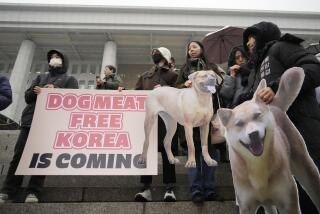A Frank Discussion : Yes, hot dogs are a high-fat, guilty pleasure. But a connection between frankfurters and cancer in kids? Say it ain’t so.
- Share via
First it was Alar on the apples in Mom’s apple pie. Then it was pesticide residue in the milk from mother’s breast.
Now we’re supposed to worry about the last remaining all-American food: the humble hot dog.
And just in time for the Fourth of July.
As icons go, the hot dog’s halo has been slipping for some time. Decades ago, frankfurters were identified as a leading cause of choking death among young children.
They became even more of a guilty pleasure when federally mandated food labels confirmed hot dogs’ high-fat, high-sodium constitution. In 1992, the federal government included hot dogs on a list of foods that can be hazardous if not fully cooked.
So it comes as no surprise that these slippery pink logs of unspecified animal innards are not health food.
But--hot dogs and leukemia?
That’s the relationship being investigated in the wake of recent findings by USC researchers, who compared the hot dog intake of 232 Los Angeles children who developed leukemia to a matched group of children who did not.
According to USC epidemiologist John Peters’ report in a cancer research journal, children who eat more than 12 hot dogs per month have nine times the normal risk of developing childhood leukemia.
Two other reports in the same issue of Cancer Causes and Control suggest that children born to mothers who ate at least one hot dog per week while pregnant have twice the risk of developing brain tumors, as do children whose fathers ate too many hot dogs before conception.
“Geez, wasn’t it just last week we had that popcorn scare?” says Lon Rosenberg, who proudly oversees hot dog concessions at Dodger Stadium. “Now they’re after Dodger Dogs! Enough is enough.
“When I was growing up, I ate at least a dozen dogs a month at the ballpark. And I’m sure my kids eat that many now,” Rosenberg says. “If there was anything wrong with that, my friends at Farmer John would’ve warned us, wouldn’t they?”
Sure would, say the folks at Farmer John, who make Dodger Dogs. They, like the dozens of other hot dog manufacturers, are steamed about all the media attention over what they call an “obviously flawed” study.
“They shouldn’t have released the study,” Farmer John spokesman Ron Smith says. “It doesn’t do any good. Why cause such a ruckus?”
“Trust me, we never meant to cause a ruckus,” says Peters, still reeling from the reaction to research quietly published last March. “We never set out to indict hot dogs.
“Dietary exposure to processed or cured meats was part of a little side questionnaire to our study on (electro)magnetic fields. We were as surprised as anyone by the hot dogs findings. . . . It was the biggest risk for anything we saw in the study--about four times the risk for EMFs.”
Any cancer in children is considered very rare. Acute lymphoblastic leukemia strikes only about three in every 10,000 children, so even a ninefold increase still presents a relatively small risk.
Even so, some health experts, including Peters’ group, suggest that children reduce their consumption of hot dogs and other processed foods--such as bacon, ham and bologna--until more is known about the danger.
For now, no one knows what the connection is between hot dog-heavy diets and childhood cancer, or even if it is a cause-and-effect link. “Is it the mustard or the ketchup or the relish or the . . . bun? We operate in a state of ignorance on such questions,” Peters says.
*
Only one of the ingredients in a typical hot dog sandwich is a known carcinogen--and that is nitrite. The preservative, which has been found to cause cancer in animals, is added to hot dogs to protect consumers from botulism and other nasty, even life-threatening bacteria.
Proper cooking would kill most of those germs, but the dogs are often eaten raw--especially by kids. Because the government considers processed meats “fully cooked and ready to eat,” some packages do not warn consumers to cook them further.
The risk from bacteria appears to be far greater than that from nitrites, so substituting one of the various nitrite-free brands on the market may pose different hazards.
Some pediatricians, including Dr. Nick Roulakis of Arcadia, say studies such as Peters’ validate his family’s decision to avoid cured meats altogether.
“They are not a crucial part of our diets,” Roulakis says. “In fact, we know that complex carbohydrates like pasta and cereals are much better for children, as well as for adults.”
*
For ease of preparation, cost-per-serving and fun-per-bite, hot dogs may well be the perfect food. “For two-career ‘90s families with picky eaters like mine,” says Eileen Marsh of Los Angeles, “I’m not sure I can even imagine life without hot dogs. . . . I haven’t told the kids yet. I’m going to wait till we finish off this last pack in the fridge.”
And what about the Fourth of July?
“It’s just as patriotic to eat healthy hot dogs,” says Eric Hawkins, a buyer for Wild Oats Community Market in Pasadena. “We’ve got a nice supply here of tofu-based Smart Dogs and Soy Boys. Very nice on the barbecue. . . .”
More to Read
Eat your way across L.A.
Get our weekly Tasting Notes newsletter for reviews, news and more.
You may occasionally receive promotional content from the Los Angeles Times.










